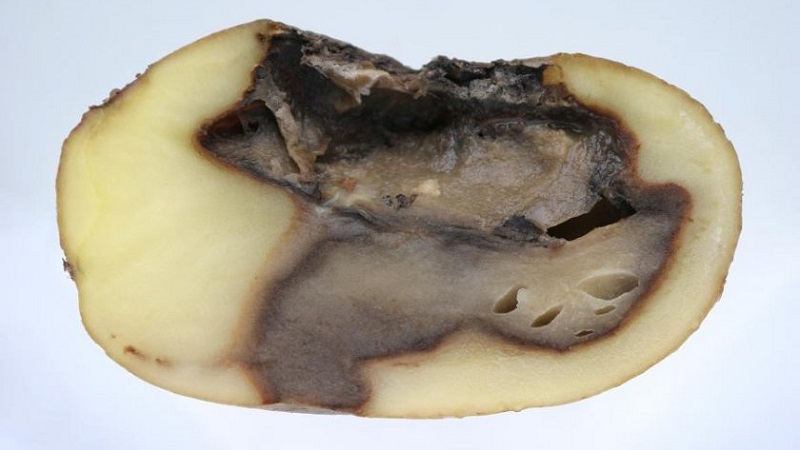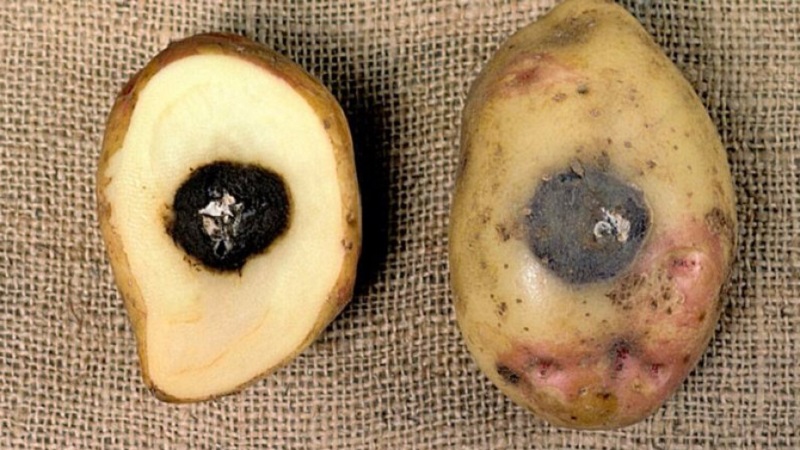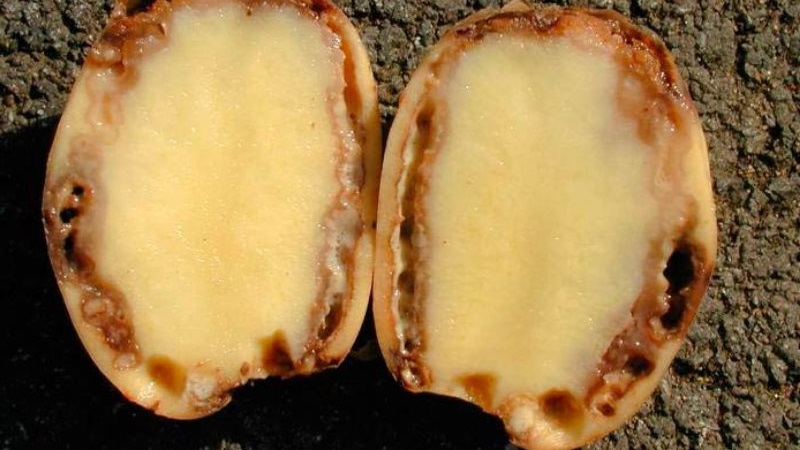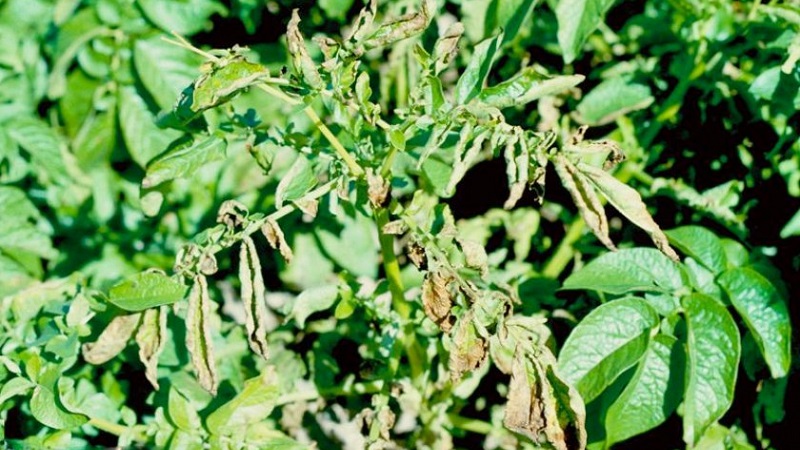What to do if potatoes rot in the ground and why this happens
Potato diseases, especially various types of rot, are the scourge of many gardeners. It is very difficult to recognize the development of the disease in the early stages, and sowing in infected soil is fraught with damage to the tubers. How to treat potatoes from mold, why does it rot in the ground and what should be done if it is infected? Read the answers to these and other questions below.
The content of the article
Types of potato rot
Mold on potatoes - rot caused by fungal and bacterial infections... The fight against them is complicated by the abundant damage to the soil and the complexity of its processing. Also, the development of rot is facilitated by violations of the rules of crop rotation and agricultural technology - irrigation and fertilization.
Wet
Wet potato rot is caused by several types of bacteria. They penetrate into the tuber with mechanical and fungal skin lesions.

Early disease begins in the ground or during harvest, however, with excessive watering or during the rainy season, it develops to a late stage already in the soil, infecting it with bacterial spores. Another cause of the disease is the lack of hilling of tubers and their "suffocation". Rot grows best in tubers that have been exposed to subzero temperatures during storage.
At the last stage of development, the disease is difficult to confuse with others. The inner part of the tuber softens to a liquid state and acquires a pronounced unpleasant odor... At the initial stages, the peel is not touched, but at later stages, softening and liquefaction of the tuber reaches it. Dark wet patches appear on the affected tubers. When squeezed onto the surface through cracks, an internal liquid starch mass is released.
To combat wet rot, it is necessary to follow the rules for storing seed:
- lay only whole tubers;
- do not expose the seed to hypothermia;
- store in dry ventilated rooms and disinfected boxes;
- to treat seed tubers with drugs against fungi and bacteria ("Glyocladin", "Microcid").
It is impossible to cure the disease... If rotten potatoes are found in the ground, all tubers within a radius of 20-30 cm are destroyed.
Interesting on the site:
How to deal with scab on potatoes and heal the land
What is potato late blight: description and treatment methods
Dry
Fusarium, or dry rot of potatoes, refers to diseases of fungal origin. The pathogen is very quickly transmitted from tuber to tuber and can destroy up to a quarter of the entire crop... Defeat with dry rot provokes the addition of a secondary infection.

The main causes of potato infestation include mechanical damage to seed and growing tubers during hilling, damage by insect pests, waterlogging, excessive manure in the soil.
Not only potatoes are infected, but also other nightshades - tomatoes, eggplants, peppers, as well as garden strawberries and wild strawberries.
In the affected plant, the tips of the leaves brighten, as the disease progresses, they become whitish... A characteristic pink bloom appears on the stems. At first, brown spots form on the tubers, which gradually increase, the affected areas dry out and form voids with white bloom inside.
It is impossible to cure the disease... Measures to prevent contamination of seed and soil include:
- compliance with the rules of crop rotation and agricultural technology;
- regular inspection of plantings for damage to stems and foliage;
- use for sowing only whole intact potatoes;
- removal of infected bushes together with tops and tubers by burning.
In no case do not put the affected stems in the compost heap.
Fomoznaya
Phoma rot (button rot, button disease, phomosis, potato gangrene) is a disease caused by several types of fungi. Phomosis is considered one of the most dangerous fungal diseases of potatoes.... The infection is spread by airborne droplets in rainy, cool weather. Spores settle on the stems or enter the soil with water droplets.

Plants affected by button rot die, tubers do not have time to ripen... Foci of infection very quickly develop into an epidemic and affect up to 100% of plantings. In terms of danger, phomosis is second only to late blight.
The first signs of potato gangrene appear during the flowering period.... Dark elongated spots appear on the leaf petioles at the base, which gradually cover the entire stem. The affected foliage dies off quickly, falling off and infecting the soil.
On developed tubers, rounded depressed spots first appear, similar to traces of buttons. On the cut, under the dark spot, a translucent strip is visible, containing the wastes of the fungus. Further, cavities with a gray fungal bloom are formed in the tubers. As a result, the tuber dries out almost completely, leaving only dead tissue.
It is impossible to fight the disease... All forces are directed to the prevention of infection and suppression of the focus of the disease:
- compliance with the rules of crop rotation and agricultural technology;
- the use of resistant potato varieties - Lazurit, Rosinka;
- compliance with the rules for storing seed;
- its treatment with fungicidal preparations "Ditan M-45", "Rovral Aquaflo";
- inspection of potato bushes and removal of affected plants entirely by burning.
Annular
Ring rot is a bacterial infection. It develops slowly, while affecting up to 40-45% of the crop... The tubers are infected first, and then the whole plant. You can track it only by observing the growth of the aerial part of the bush.

The first signs appear during the flowering period.... Bushes wither and fall to the ground, which is considered a hallmark of ring rot. Small brown spots appear on the tips of the leaves. The leaves themselves become whitish and speckled. The lower ones twist up. With the development of the disease at an early stage of growth of the bushes, they are shortened compared to healthy ones.
On the cut of diseased tubers, yellowing and softening along the vascular ring are noted already at an early stage.... As the disease progresses, the entire vascular system of the tuber is destroyed, turning into a single mucous mass.
The disease progresses at high humidity and temperatures above + 20 ° C... In dry hot weather, development slows down to a complete stop. The bacteria do not linger in the soil, which makes it easier to fight them. The source of infection for healthy tubers is exclusively affected.
To prevent the disease, the following measures are used:
- use of resistant varieties - Merrimack, President, Teton, Frizo, Furor;
- compliance with the rules for storing seed potatoes;
- identification and removal of diseased plants;
- compliance with the rules of crop rotation and agricultural technology;
- sprouting potatoes before planting;
- treatment of storage sites for seed, for example, with a slightly pink solution of potassium permanganate.
Rubber
Rubber rot appeared on the territory of Russia relatively recently compared to other species. It affects seed germination and plant productivity, as well as the safety of tubers... The disease has a fungal origin and two forms - tuberous and sprout.

The pathogen enters the tubers through the eyes, lentils and mechanical damageobtained during sowing, processing or caused by insect pests.
The tubers are covered with brown spots of irregular shape with a black border around the entire perimeter. To the touch, the spots are dense, elastic, similar to rubber. On the cut, the affected tissue first turns pink, after which it becomes brown and black. When pressed, a brown content with a fishy smell is released from the cut tubers.
Rubber rot develops at high soil moisture and in acidic soil at temperatures above + 20 ° C... The sources of infection are infected seed tubers, soil residues and fungal spores in the soil.
Control measures:
- compliance with crop rotation;
- improvement of planting material;
- deep plowing of the soil;
- loosening in heavy rain;
- compliance with the storage regime for seed.
Important! There are no varieties that are resistant to rubber rot.
The main causes of potato rotting in the ground
Why do potatoes rot from the inside? The main reasons are:
- violations in agricultural technology - excessive watering, absence or, conversely, excessive loosening, irregular weeding;
- non-compliance with the rules of crop rotation - this applies to rot with a fungal etiology;
- use of diseased seed.
What is the source of infection
A source of fungal rot infection become affected tubers and spores remaining in the soil, rot of bacterial origin - infected tubers. In both cases, an additional source may be diseased tops, remaining in the soil or used as compost.

How to deal with potato rot
It is almost impossible to fight rot on diseased plants... All control measures are reduced to the removal of a diseased bush and the prevention of morbidity in neighboring ones at a distance of at least 1 m.
Prevention measures
Prevention measures for all types of rot include:
- compliance with the rules of crop rotation and agricultural technology;
- proper storage and handling of seed;
- the use of varieties that are resistant to one type of rot or another;
- regular inspection of the bushes for morbidity.
For prevention, the land must be cultivated 50-100 g of copper sulfate per 10 liters of water or 100-200 g of Bordeaux liquid per 10 liters of water. An alternative option is copper-based fungicides, for example, "Ordan", "HOM".
Read also:
Can I eat potatoes with a white bloom
Eating potatoes if mold appears, it is highly undesirable even when removing the affected area. In sick tubers, toxins accumulate, secreted by this or that pathogen. Eating such potatoes will cause gastrointestinal upset, general body poisoning and other consequences, up to and including death.
Conclusion
Potato rot is a group of dangerous diseases that lead to the loss of a large part of the crop. It is useless to treat the affected bushes - they are immediately removed to avoid infection of neighboring plants. To prevent potatoes from becoming moldy, it is important to follow the rules of crop rotation, agricultural technology and prevention.